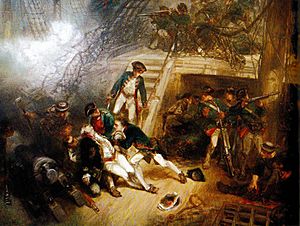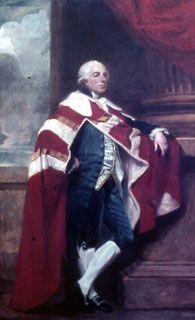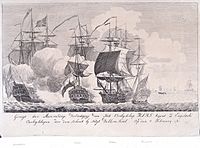Action of 4 February 1781 facts for kids
Quick facts for kids Action of 4 February 1781 |
|||||||
|---|---|---|---|---|---|---|---|
| Part of the Fourth Anglo-Dutch War | |||||||
 The death of Willem Krul, by Charles Rochussen |
|||||||
|
|||||||
| Belligerents | |||||||
| Commanders and leaders | |||||||
| Strength | |||||||
| 2 ships of the line 1 frigate |
1 ship of the line 30 merchant ships |
||||||
| Casualties and losses | |||||||
| 3 wounded | 7 wounded 8 killed 1 ship of the line captured 30 merchant ships captured |
||||||
The Action of 4 February 1781 was a small but important naval battle. It happened on February 4, 1781, near Sombrero island in the Caribbean Sea. This fight was part of the Fourth Anglo-Dutch War.
A British fleet, led by Captain Francis Reynolds-Moreton, 3rd Baron Ducie, faced a Dutch ship. The Dutch ship was protecting 30 merchant ships. The battle ended with the British capturing all the Dutch vessels. This event took place soon after the British had taken over the Dutch colony of Sint Eustatius.
| Top - 0-9 A B C D E F G H I J K L M N O P Q R S T U V W X Y Z |
Why This Battle Happened
The Fourth Anglo-Dutch War started because of disagreements between Great Britain and the Dutch Republic. The Dutch had been secretly helping the American rebels during the American Revolutionary War. They supplied the Americans with goods and weapons. This made Britain very unhappy.
In 1780, Britain declared war on the Dutch. The war mostly involved Britain capturing Dutch colonies. Admiral George Brydges Rodney was sent to capture Sint Eustatius. This island was a major trading hub in the Caribbean.
Rodney's forces easily captured Sint Eustatius. They also took all the ships in its harbor. Soon after, Rodney learned that a group of 30 Dutch merchant ships had just left the island. These ships were full of valuable goods like sugar and coffee. They were heading back to the Dutch Republic. A single Dutch warship was protecting them.
Rodney quickly sent a British squadron to chase them. This group included two large warships and a smaller frigate. Captain Francis Reynolds-Moreton, 3rd Baron Ducie was in charge of this British force.
The Battle Begins

British commander
(Portrait by George Romney}
On February 4, the British ships caught up with the Dutch convoy. The British force included the ships Monarch, Panther, and the frigate Sybil. Their goal was to capture the lone Dutch warship, the Mars.
The Mars was a 60-gun ship, commanded by Rear-Admiral Willem Krull. Despite being outnumbered, Krull ordered his crew to prepare for battle. The British ships quickly surrounded the Mars.
- The Monarch sailed to one side of the Mars.
- The Sybil sailed to the other side.
- The Panther positioned itself behind the Mars. This allowed it to fire along the length of the Dutch ship.
A Brave Fight
The battle became very intense. The merchant ships tried to escape as the fighting began. The Mars fought bravely against the three British warships. For about 30 minutes, cannons roared from all sides. Rear-Admiral Krull was trying to give his merchant ships time to get away.
However, the British firepower was too much. After half an hour of fighting, Krull was badly wounded. With his last breath, he ordered his captain to surrender the ship. The Mars lowered its flag, signaling surrender.
The British quickly boarded the Mars and took control. Then, they chased after the escaping merchant ships. Without their warship escort, the 30 merchant ships were easily captured.
After the Battle
The British had very few casualties. Only three British sailors were wounded, and none were killed. The Dutch suffered more, with eight killed and seven wounded, including Rear-Admiral Krull.
Captain Reynolds-Moreton sailed back to Sint Eustatius with all 31 captured ships. The valuable cargo from the merchant ships was brought ashore. The body of Willem Krull was respectfully buried with full military honors. This was done to recognize his bravery during the battle.
The captured Dutch warship Mars was later used by the British Navy. It was renamed Prince Edward.
Captain Reynolds-Moreton continued to serve in the navy. He fought in other important battles, like the Battle of the Saintes. He later became a member of the British Parliament.
The Fourth Anglo-Dutch War ended badly for the Dutch. Their economy was greatly hurt, and they lost many colonies. While the British returned most captured Dutch colonies, they kept one in India. The war showed how weak the Dutch Republic had become.
See also



